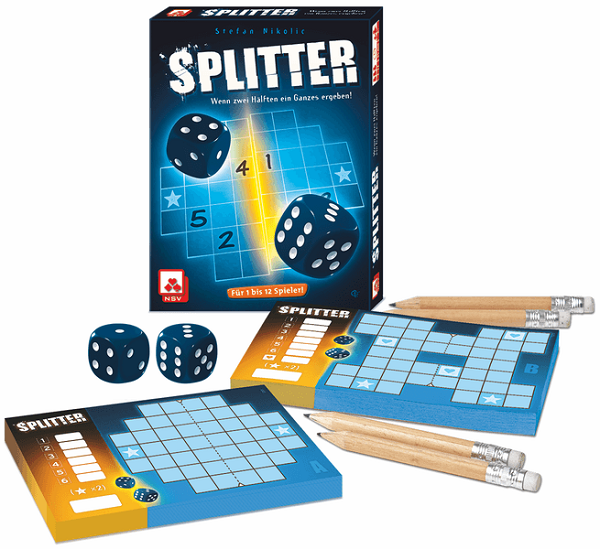Splitter: A Roll and Write of Mirrored Numbered Placement

Roll two dice and write both numbers onto your player sheet: but choose your placement wisely, as where you write a number determines exactly where the second number must be placed as well.
Published by NSV and Pandasaurus Games, Splitter is an extremely light roll-and-write game with a simple but clever concept at its heart.
Gameplay
Each player takes an identical player sheet. Each sheet shows several rows of empty squares, with different numbers of squares in the rows. Down the center runs a line which cuts each row in half. Each turn, two dice are rolled and all players must write one die result in a square on the left side of that line and one on the right. The catch is that you must place them symmetrically. So, for example, if you write one number two squares to the left from that line on the third row, then the other number must be two squares to the right from that line, and also on the third row.
Players continue rolling the dice and writing down the numbers until their sheets are completely filled. You then calculate your scores. You score points for groups of numbers if the value of the number in that group equals the number of times that number appears in the group, and the group is worth points equal to that number. For example, you can score a group of three’s if there are only exactly three three’s in it, and that group will be worth three points.
There are two different player sheets. In the simpler one, there is a single star icon on either side of the sheet. A successful number grouping is worth double points if one of the numbers is written in a square with a star. The more advanced sheet also has three heart spaces. If the same number is written in all three heart spaces on your sheet, whether they are part of scoring number groups or not, you earn five bonus points. The player with the most points wins.

Review
The core mechanism at the heart of Splitter is a lot of fun. Often at least one number placement is going to be less ideal on a turn, so you’re figuring out how best to mitigate that, while still working towards scoring number groupings.
It’s nice that there are two different player sheets you can use, and the solo mode is a nice little addition. There’s nothing in the rules to make it significant when it’s your turn as opposed to another player’s and there’s nothing included to actively prevent players from making the same choices as each other every turn. However, there’s a charm to the barebones, simple rules approach. The game itself is quite fast to play, and it’s nice to have something you can teach in under two minutes and that fits a wide player range.
The paint on one side of one of the die was faded in our copy, and the included pencils aren’t the best, but overall the component quality is good enough, and the game is quite portable and small.
Splitter isn’t likely to be anyone’s favorite roll and write, but for fans of the genre it’s a nice little addition that’s both fun and engaging, and it’s satisfying to see how high you can score.
Pros: Fun core concept, easy to teach, fast to play
Cons: Components could be a little better, no player interaction, nothing to stop players from making the same choices
Disclosure: we received a complimentary review copy of this game.






